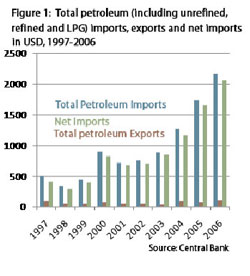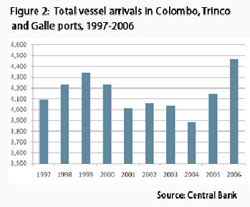
| 24/03/2010 - Lanka Business on Line | |||
| Prerequisites for making Sri Lanka an energy hub | |||
|
Mar 24, 2010 (LBO) - Sri Lanka is to become a “Naval, Aviation, Commercial, Energy and Knowledge hub.” Of the five hub visions, this is the longest shot. But not impossible, especially if combined with the plan for a shipping hub (I assume the intention was talk about civilian shipping, and not about ships with guns, as suggested by the term naval). |
|||
| Why long shot? | |||
|
Sri Lanka is an energy deficit country; we import most our energy and our imports are increasing. We have short memories, but not so short as to forget the rolling blackouts of 2002 that were ended with emergency generation. Just a few months without rain and we’ll be in darkness. A hub implies energy coming in and out, through the spokes. Singapore does not have its own energy sources, but is energy-surplus. Energy in different forms is shipped in; energy that has been transformed (and not used domestically) is shipped out; Singaporeans do not suffer rolling blackouts. Energy costs and reliability are not factors in the decision to locate a firm in Singapore. Sri Lanka imports most of its energy, expect for the hydro that is almost tapped out and the biomass (firewood) that too many of our households still use for cooking. Figure 1 shows we are far from being an energy hub, with negligible energy exports.
Prerequisites for an energy hub The Mahinda Chinthana Idiri Dekma envisions 10,000 ships coming into the Hambantota port a year, in addition to arrivals increasing in Colombo (including the new South Colombo Port). This is a tripling of traffic. Figure 2 shows that the target is rather ambitious in light of historical traffic trends.
A hub is about imports, value addition, and exports (or, in the event the Cauvery Basin yields oil or natural gas for Sri Lanka, greater emphasis on value addition and exports). Given we’ve been talking about oil from Pesalai for close to four decades, I will focus on the scenario that involves imports. It makes a lot of sense to put a massive oil refinery in Hambantota. Unlike the too-small-to-be-economical refinery in Sapugaskanda, this should be a monster, way bigger than what is justified by projected domestic demand. The intention should be to add value and export. Petroleum markets are too complex for government bureaucrats to play in (as amply demonstrated by the oil hedging fiasco) so it is best that this be bid out to a major international player. The business case should also include bunkering for ships. I have always been skeptical about ships choosing to come to a port simply because of proximity to shipping lanes. But coming to a proximate port that offers cheap bunkering and other port services is a different matter. This would automatically increase both imports and value-added exports and would also improve Sri Lanka’s domestic energy supplies and security. Another way we could become an energy hub is by building a large nuclear plant capable of exporting electricity to Tamil Nadu. How would electricity be exported across the Palk Strait? Undersea cable or a conduit under a bridge to be built connecting Talai Mannar and Rameswaram. Because transmission losses should be minimized and because nuclear plants do not require proximity to ports, the plant should be built close to Mannar. I can hear the shock. Nuclear for Sri Lanka? What about the danger? What about climate change? Sri Lanka is currently downwind of a large nuclear plant, Kalpakkam in Tamil Nadu. We get the danger, but none of the benefits. My suggestion is that we get the benefits too. Build a safe plant (and work with India to make Kalpakkam safer). Climate change? Nuclear is far superior to coal and oil. And it need not be said that it’s best the plant is operated by a properly incentivized entity (that means, not government-owned and operated, though there could be government shares) and subjected to strict and smart regulation. How will all this benefit Sri Lankans? If Sri Lanka becomes a true energy hub, it will cease to be an energy-deficit country. As Minister Milinda Moragoda stated when introducing the Public Utilities Commission Bill in Parliament in on October 8th, 2002: A power utility that only delivers electricity part of the day, and even then unreliably, causes businesses and consumers -- who can afford them -- to buy generators to compensate for what the utility does not deliver. This adds to costs, disadvantaging small business, big businesses, and households, alike. All face the same problem in their own way, whether it is a small business trying to make ends meet, or parents worried about a child with no light to study by. So, as much as this bill is about regulatory reform, it is also about jobs, those we already have, and those we must create and about conditions in the home. The government is committed to creating new jobs and fast-paced growth. The cost of utility services is an important component to the cost of production, to the cost of goods and services, both at the firm level and across the economy as a whole. And, who among us would condemn a child to study in the dark, Mr. Speaker? Supplying enough power is a necessary condition. The proper incentives for efficiency, adequate supply and distribution, and reasonable pricing must exist. Because electricity markets are not competitive, a good policy environment and an effective regulatory agency are necessary. Again, from Moragoda’s speech: We know from studies that in most countries where the electricity market remains a monopoly -- state-owned or otherwise -- a strong regulatory mechanism, including public hearings concerning utility proposal for tariff revisions, remains in place. This means that successful countries separate the regulatory function from the industry itself in order to assure fair rulings and a proper tariff structure, with professional oversight to manage the process. Not only have we lacked such a mechanism to assure fair, professional decisions, we have approached tariffs with the provider assuming the roles of witness, judge and jury when it comes to issues and pricing. Mr. Speaker, with the public utilities commission bill, we simply acknowledge a long-standing need, a recognized need, a need which when satisfied will serve the producer, the consumer, as well as the line ministries. All can demonstrate a competence and a transparency for a pricing process that is common to developed countries because it works. Most important, we will have done the intelligent thing on our own behalf. Right now, we are operating with a blindfold, and we must remove the blindfold. Unless we do, we take a step back, not a step forward toward the efficiency we must have from this sector, and creating the conditions toward greater prosperity for all. The Public Utilities Commission of Sri Lanka had a rocky start, with the Electricity Reform Act that was approved in Parliament, being illogically withdrawn due to misguided special interests. But it exists and its design has withstood stress tests. In addition, the fact that the PUCSL is a multi-sector regulatory agency, the only one in our region, is an added advantage. It allows the regulatory regimes for different forms of energy to work together seamlessly. Making Sri Lanka an energy hub is a long shot. But not an impossible one, if the principles spelled out in the “Sri Lanka National Congress Agenda for Influencing the Government” are followed:
|
|||
 For Sri Lanka to become an energy hub, energy exports must increase (not necessarily limited to petroleum products, but could include electricity and compressed natural gas too). Of course, if oil is discovered in Pesalai (as we have been promised since the 1970s), exports may exceed imports. Even if not, the gap between imports and exports can narrowed through value addition and exports as in Singapore.
For Sri Lanka to become an energy hub, energy exports must increase (not necessarily limited to petroleum products, but could include electricity and compressed natural gas too). Of course, if oil is discovered in Pesalai (as we have been promised since the 1970s), exports may exceed imports. Even if not, the gap between imports and exports can narrowed through value addition and exports as in Singapore. Without getting into the details of the shipping hub proposal (to be dealt with in a future article on consolidating our position as a shipping hub), let us look at how the new Hambantota Port can help realize the vision of making Sri Lanka an energy hub.
Without getting into the details of the shipping hub proposal (to be dealt with in a future article on consolidating our position as a shipping hub), let us look at how the new Hambantota Port can help realize the vision of making Sri Lanka an energy hub.